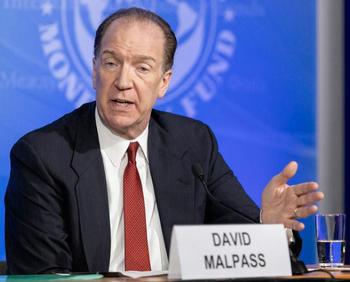
WASHINGTON, DC, October 5, 2020 (ENS) – President Donald Trump returned to the White House Monday evening aboard his helicopter just before seven, and his first actions alarmed health professionals.

Still infected with COVID-19, Trump quickly removed his face mask. He appeared to be gasping for breath, but Trump urged Americans not to fear the deadly coronavirus that sent him to Walter Reed National Military Medical Center in Bethesda, Maryland for treatment of the respiratory disease on Friday night.
Inside the White House, the virus is spreading fear, and some staffers are staying home. White House press secretary Kayleigh McEnany tested positive on the weekend. First Lady Melania Trump and advisors Hope Hicks and Kellyanne Conway are also sick with COVID-19.
Trump himself may not yet be completely in the clear his doctors say.
In the hospital, Trump was treated with a unique set of medications: Regeneron, Remdesivir, and the steroid Dexamethasone. He also required supplemental oxygen on Friday and Saturday.
Regeneron is an experimental anti-viral antibody cocktail first revealed in June. “We have created a unique anti-viral antibody cocktail with the potential both to prevent and treat infection, and also to preempt viral ‘escape,’ a critical precaution in the midst of an ongoing global pandemic,” said George Yancopoulos, M.D., Ph.D., co-founder, president and chief scientific officer of Regeneron, a company based in Tarrytown, New York.
“REGN-COV2 could have a major impact on public health by slowing spread of the virus and providing a needed treatment for those already sick – and could be available much sooner than a vaccine,” Dr. Yancopoulos said.
Remdesivir is in a class of medications called antivirals. Approved by the U.S. Food and Drug Administration to treat COVID-19 in May, it works by stopping the virus from spreading in the body.
Dexamethasone is a corticosteroid used to treat inflammation in COVID-19 patients. The World Health Organization, WHO, says it was tested in hospitalized patients with COVID-19 in the United Kingdom’s national clinical trial RECOVERY and was found to have benefits for critically ill patients.
Preliminary findings shared with WHO show that for patients on ventilators, the steroid treatment reduced mortality by about one third, and for patients requiring only oxygen, mortality was cut by about one fifth. As the treatment lasts less than two weeks, even at high doses, corticosteroids are not usually associated with serious side effects.
However, prolonged use for more than two weeks may be associated with glaucoma, cataract, fluid retention, hypertension, psychological effects such as mood swings, memory issues, confusion or irritation, weight gain, or increased risk of infections and osteoporosis, WHO said.
Trump will continue treatment at the White House Medical Unit.
Contact Tracing Not Wanted
White House officials have reportedly turned down offers from the U.S. Centers for Disease Control and Prevention, CDC, to provide resources to help contact trace the outbreak that infected the president, his wife and staffers.
“USA Today” reports that the CDC extended the offer “almost immediately” following Trump’s diagnosis, and the offer was extended again during a phone call Monday with the White House Medical Unit.
Used to investigate the source of an infectious disease outbreak, contact tracing is the process of identification of all persons who may have come into contact with an infected person, such as President Trump, and collection of further information about these contacts.
The CDC says contact tracing helps protect the infected person, family and community by:
* – Letting people know they may have been exposed to COVID-19 and should monitor their health for signs and symptoms of COVID-19.
* – Helping people who may have been exposed to COVID-19 get tested.
* – Asking people to self-isolate if they have COVID-19 or self-quarantine if they are a close contact.
The CDC offers more online help in controlling the disease, click here for access.
Superspreader Event at the White House
The White House cluster of positive cases appears to have arisen from a packed event in the Rose Garden on September 26 to introduce conservative Judge Amy Coney Barratt as the president’s pick to fill the U.S. Supreme Court vacancy left by the death in September of the more liberal Justice Ruth Bader Ginsberg.

The administration is rushing Barrett’s nomination through the process in hopes of getting her confirmed by the U.S. Senate in time to hear a case of November 10 that could dismantle the Affordable Care Act in the middle of the COVID-19 pandemic, with thousands of Americans falling ill every day and deaths rising above 210,000.
As the ninth Supreme Court justice, Barrett could also tip the balance of a close presidential election. President Trump squares off with former Vice President Joe Biden on November 3 in an election that will include millions of mail-in ballots sent by people who want to avoid catching COVID-19 at in-person polling places.
The ceremony on September 26, attended by more than 150 people, featured indoor receptions as well as the outdoor announcement. Attendees were hugging, speaking closely together and shaking hands – all without masks.
At least 11 people who attended, including a news photographer and a White House journalist, have tested positive for the virus. They include former New Jersey Governor Chris Christie, former top Trump aide Kellyanne Conway, Republican Senators Thom Tillis of North Carolina and Mike Lee of Utah, and University of Notre Dame President John Jenkins.
Barrett herself had the virus during the summer and appears to have recovered.
Democrats called for a delay in Barrett’s confirmation hearing, but Senate Republicans said they will move forward. Senator Lindsey Graham, a South Carolina Republican who chairs the Judiciary Committee, said in a tweet Friday that the hearings remain scheduled to begin October 12 and said virtual hearings are possible.
Going Forward
Dr. Sean Conley, DO, physician to the president, said he and the rest of the White House medical team will maintain a “vigilant watch” over the Trumps and that he expects “the President to continue carrying out his duties without disruption while recovering.”
“The President and First Lady are both well at this time,” Conley said. “And they plan to remain at home within the White House during their convalescence.”
President Trump tweeted Monday that he feels good. “Don’t be afraid of Covid. Don’t let it dominate your life. We have developed, under the Trump Administration, some really great drugs & knowledge. I feel better than I did 20 years ago!”
But Dr. Anthony Fauci, director of the National Institute of Allergy and Infectious Diseases, says doctors must be “heads up” for a possible reversal of Trump’s condition after the president left Walter Reed Medical Center Monday evening.
Fauci told CNN’s Chris Cuomo, “The issue is that he’s still early enough in the disease that it’s not a secret that if you look at the clinical course of people, sometimes when you are five to eight days in, you can have a reversal. A reversal meaning going in the wrong direction and getting into trouble.”
Copyright Environment News Service (ENS) 2020. All rights reserved.



